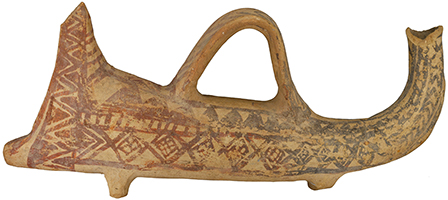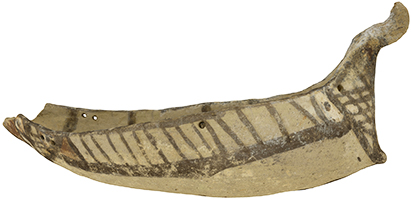Ship to the right, with two birds in flight above and two fish below, facing in the same direction. The hull is rendered by a continuous thick flat line that thins out into a markedly incurving high sternpost ending in three short projections. There is a large triangular steering oar. The bow consists of a vertical post with lattice work depicted by two parallel lines joined together by oblique strokes, an incurving extremity, and a bow projection below it. There are six short horizontal timbers projecting outward from the stem. The vertical lines above the gunwale are tholepins, there are no stanchions depicted. There are three parallel horizontal lines of uniform thickness above the hull. I interpret these as a deck and raised sides (wales) offering lateral protection for the rowers. The mast is slightly forward of amidships and forked at the top, with only a forestay. There are two spears and the shaft of a third stacked upright in the hull at the stern.
Galley
A114
850-825 B.C. (MG I)
Lefkandi, Toumba cemetery, fill of tomb no. 61 from a disturbed burial context
Vessel H: 29 cm; max. diam.: 27.5 cm
Large globular pyxis, light red clay, deep buff slip, brown paint. Significant parts of the sides, neck, and shoulder are missing. The top and bottom halves do not quite join.
Eretria Museum 16633
Calligas 1990: 77-79, fig. 1; Nakas 2011: fig. 6; Popham 1987; Wedde 1999a: 510-11; 2006: 260, fig. 5
The find is out of context. The pyxis has been reconstructed from fragments found mixed together with numerous other sherds in the fill of tomb 61 as well as the soil which was used to level the area above it. Lying near the northeast limit of the Toumba cemetery, tomb 61 was otherwise found empty and was probably unused. In the process of excavating the shaft, grave diggers appear to have destroyed an early MG I tomb along with most of an adjacent SPG I pyre (no. 21), reusing part of their contents to refill the shaft. The pyxis with the ship depiction likely came from the disturbed tomb which Popham has identified as a female burial. The offerings attributed to it include nine pyxides (two Attic imports), a globular amphora, a plain gold diadem, a gold attachment, a bronze pin, and faience beads. Six of the locally made pyxides were considered to similar that they are presumably from the same workshop (Popham 1987: 353-355).
The vase is a large version of a typical local globular pyxis. Decoration is in the local style, and includes panels filled with cross-hatched motifs of swastikas, linked lozenges and battlement. Below the rim are two pairs of holes for securing a lid, with three such lids found in the fill.
Although this is a fairly minimalist depiction, the important structural elements are there. Wedde assigns the bow morphology to his group 2 alongside the Tragana and the Khaniale Tekke ships, for which it may represent a possible link between the two. It is defined by a "rudimentary bow projection, a vertical stem with lattice work and no integration into the mass of the bow."(Wedde 2006: 260).
There are important commonalities with the LG I vessels, most notably the three horizontal lines which are there depicted as a central thick black band outlined by two thinner ones which Casson identifies as the deck and wales. The pictorial similarities both with these later Dipylon ships, and the earlier Kynos ship in terms of indicating a substantial beam suggest that the Toumba ship must also be decked (Wedde 1999: 510-11). Wedde argues that these must be longitudinal decks which run along each gunwale, leaving the center open for operations involving the mast. The absence of a forecastle on the Toumba vessel may also be explained by the fact that the ship is decked. The longitudinal stiffening provided by the deck, as well as the reinforcing of the sides by the wales were essential prerequisites for the development of the ram - the fact these are highlighted on the Toumba vessel is no incident. The development of the deck was also an essential component towards the evolution of the two-levelled ship, with the second level of rowers on deck. A number of other details also likens this depiction to the later Dipylon ones, such as the horizontal plank protrusions along the stem, and the incurving stempost with a three-pronged device. The theme of depicting spears, including similarly placed in the stern is also a recurrent motif.
Calligas, P. G. 1990. “Early Euboean shipbuilding,” in H. Tzalas (ed.) Tropis II: Proceedings of the 2nd International Symposium on Ship Construction in Antiquity, Delphi, 1987, Athens: Hellenic Institute for the Preservation of Nautical Tradition, pp. 77-83.
Nakas. Y. 2011. “Νήαι μέλαιναι: Πλοία και ναυπηγική στο Αιγαίο της Πρώιμης Εποχής του Σιδήρου (Νήαι μέλαιναι: ships and shipbuilding in the Early Iron Age Aegean).” In A. Mazarakis Ainian, (ed.) The "Dark Ages" revisited: acts of an international symposium in memory of William D.E. Coulson, University of Thessaly, Volos, 14-17 June 2007. Volos: University of Thessaly Press: 1003-1017.
Popham, M. 1987. “An Early Euboean Ship,” AJA 6.3: 353-359.
Wedde, M. 1999a. “Decked Vessels in Early Greek Ship Architecture,” in H.E. Tzalas (ed.) Tropis V: 5th International Symposium on Ship Construction in Antiquity. Nauplia, 26, 27, 28 August 1993. (Hellenic Institute for the Preservation of Nautical Tradition). Athens: Hellenic Institute for the Preservation of Nautical Tradition, pp. 505-526.
―――. 2006. “Pictorial Evidence for Partial System Survival in the Greek Bronze Age to Iron Age Transition,” in E. Rystedt and B. Wells (eds.) Pictorial Pursuits: Eigurative Painting on Mycenaean and Geometric Pottery. Paper from Two International Round-Table Conferences on Mycenaean and Geometric Pottery at the Swedish Institute at Athens in 1999 and 2001, Stockholm: Svenska Instituted I Athen, pp. 255-269.














